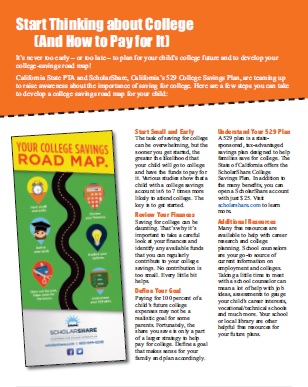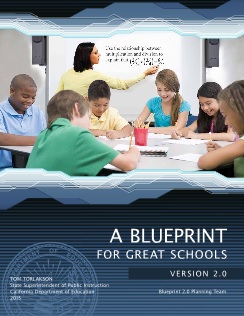 Find out more about what your child’s assessment-score report means!
Find out more about what your child’s assessment-score report means!
Download and share our helpful flier in English and Spanish – updated for the 2016 Student Score Reports.
It’s never too early – or too late – to plan for your child’s college future and to develop your college-savings road map! California State PTA and ScholarShare, California’s 529 College Savings Plan, are teaming up to raise awareness about the importance of saving for college.
 Here are a few steps you can take to develop a college savings road map for your child:
Here are a few steps you can take to develop a college savings road map for your child:
Parents of high-school students — be sure to check out this helpful flier from California Community Colleges, California State University and University of California about the new assessments and college placement.
 Recommendations for making high-quality environmental education available to all students, finding a funding source to sustain and improve instruction, working with outside organizations to ensure the instruction is high quality, and providing students with a variety of learning experiences.
Recommendations for making high-quality environmental education available to all students, finding a funding source to sustain and improve instruction, working with outside organizations to ensure the instruction is high quality, and providing students with a variety of learning experiences.
With these new guides from the California Department of Education and California State PTA, find out more about what the new assessment scores mean for your child and use them as an opportunity to work with your child’s teacher for student success!
Spanish coming soon!
A Blueprint for Great Schools Version 2.0 builds on the groundbreaking 2011 report which helped usher in a new era in California schools that has included major increases in funding, more rigorous state academic standards, online student assessment testing, and greater support for the students and schools with the most needs.
 Developed based on recommendations made by a team of 29 education leaders and experts, Blueprint 2.0 details next steps in five critical areas: California standards, teaching and leading excellence, student success, continuous improvement and accountability systems, and systems change and supports. California State Superintendent of Public Instruction Tom Torlakson said the California Department of Education will now work on carrying out the plans.
Developed based on recommendations made by a team of 29 education leaders and experts, Blueprint 2.0 details next steps in five critical areas: California standards, teaching and leading excellence, student success, continuous improvement and accountability systems, and systems change and supports. California State Superintendent of Public Instruction Tom Torlakson said the California Department of Education will now work on carrying out the plans.
The Blueprint 2.0 Planning Team was co-chaired by Martha Infante, a teacher at the Los Angeles Academy Middle School; David Rattray, Executive Vice President, Education and Workforce Development for the Los Angeles Area Chamber of Commerce and President of UNITE-LA, the school-to-career partnership of Los Angeles; and Chris Steinhauser, Superintendent of the Long Beach Unified School District.
As well as detailed recommendations, A Blueprint for Great Schools Version 2.0 includes a call to action, a revised mission, and a review of guiding principles and the emerging “California Way.”
“We have worked hard to move forward together in California in a gradual, sensible, and collaborative way,” Torlakson said. “I call this approach ‘The California Way,’ and it is paying huge dividends across the board. Blueprint 2.0 is the latest example of what The California Way can do.”
The new assessment report uses four achievement levels: standard not met, standard nearly met, standard met, standard exceeded. The levels will designate the degree of “progress toward mastery of the knowledge and skills needed for success in future coursework.” For 11th-graders, they measure the degree to which students are on track to be ready for college or a career after graduating from high school. Download the sample Student Score Report for 2016-2017.

Learn More:
 An arts education task force formed by California Superintendent of Public Instruction Tom Torlakson is calling for arts education to be elevated to a core subject and be available to all students.
An arts education task force formed by California Superintendent of Public Instruction Tom Torlakson is calling for arts education to be elevated to a core subject and be available to all students.
“We have been extremely fortunate to have such a knowledgeable and creative group committed to helping our state rebuild its infrastructure for arts education,” Torlakson said. “The picture they paint is one of a relevant, robust and dynamic curriculum to keep kids in schools, narrow the achievement gap and give students an opportunity to discover and develop their individual talents. But they also highlight the need to make certain all students have access to arts education so they can explore their own artistic vision.”
California State PTA representatives served on the group that developed the Blueprint, and the association is part of the CREATE CA Coalition dedicated to building public will around the recommendations.
Download and view a copy of the Blueprint for Creative Schools.
 Student assessments are changing. For years, most year-end tests were mainly multiple-choice exams that focused on basic skills. These tests did a poor job of measuring the skills students need for success after high school—like writing, critical thinking, and problem solving. With new education standards, states are working together to develop quality tests. In 2014-15, schools will replace their old tests with new assessments built to let parents and teachers know how well students are learning the skills and knowledge they need to succeed in today’s world.
Student assessments are changing. For years, most year-end tests were mainly multiple-choice exams that focused on basic skills. These tests did a poor job of measuring the skills students need for success after high school—like writing, critical thinking, and problem solving. With new education standards, states are working together to develop quality tests. In 2014-15, schools will replace their old tests with new assessments built to let parents and teachers know how well students are learning the skills and knowledge they need to succeed in today’s world.
Learn more about what the new tests are trying to accomplish and what you can be looking for locally on the Education pages of our Focus Areas section.
Download, print and share the flier from National PTA for more information.